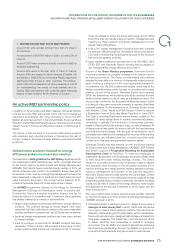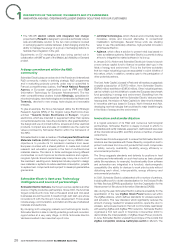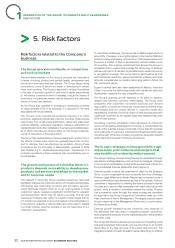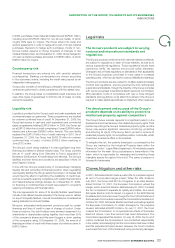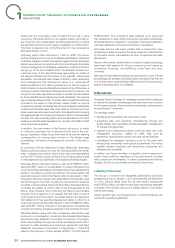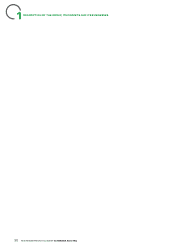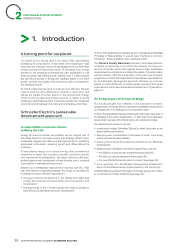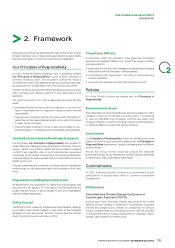APC 2009 Annual Report Download - page 35
Download and view the complete annual report
Please find page 35 of the 2009 APC annual report below. You can navigate through the pages in the report by either clicking on the pages listed below, or by using the keyword search tool below to find specific information within the annual report.
2009 REGISTRATION DOCUMENT SCHNEIDER ELECTRIC 33
DESCRIPTION OFTHEGROUP, ITSMARKETS ANDITSBUSINESSES
1
RISK FACTORS
In 2009, purchases of raw materials totalled around EUR 951million,
including around EUR 436million for non-ferrous metals, of which
roughly 59% were for copper. The Group enters into swap and
options agreements in order to hedge all or part of its raw material
purchases. Decisions to hedge such purchases, mostly of non-
ferrous metals, depend on Group forecasts of changes of raw
material market prices. As of December 31, 2009, Group hedges for
non-ferrous metal purchases amounted to EUR 85million, of which
EUR 54million for copper.
Counterparty risk
Financial transactions are entered into with carefully selected
counterparties. Banking counterparties are chosen according
to the customary criteria, including the credit rating issued by an
independent rating agency.
Group policy consists of diversifying counterparty risks and periodic
controls are performed to check compliance with the related rules.
In addition, the Group takes out substantial credit insurance and
uses other types of guarantees to limit the risk of losses on trade
accounts receivable.
Liquidity risk
Liquidity is provided by the Group’s cash and cash equivalents and
commercial paper programmes . These programmes are backed
by undrawn confi rmed lines of credit. At December 31, 2009, the
Group had access to cash and cash equivalents and commercial
paper programmes totaling EUR 3.5billion. In 2009, the Group set
up a EUR 1.8billion line of credit comprising a 3-year EUR 900million
tranche and a fi ve-year EUR 900million tranche. This new facility
replaced the EUR 1.6billion line of credit maturing in 2010. As of
December 31, 2009, the Group had EUR 2.75billion in undrawn
confirmed lines of credit, of which EUR 2.6billion maturing in
June2012 or later.
The Group’s credit rating enables it to raise signifi cant long-term
fi nancing and attract a diverse investor base. The Group currently
has an A- credit rating from Standard & Poor’s (upgraded in
November2008) and an A3 credit rating from Moody’s. The Group’s
liabilities and their terms and conditions are described in Note24
(see Chapter5 below).
In line with the Group’s overall policy of conservatively managing
liquidity risk and protecting its fi nancial position, when negotiating
new liquidity facilities the Group resists the inclusion of clauses that
would have the effect of restricting the availability of credit lines,
such as covenants requiring compliance with certain fi nancial ratios
and material adverse change clauses. As of December 31, 2009,
no fi nancing or confi rmed lines of credit were subject to covenants
requiring compliance with fi nancial ratios.
The loan agreements for some of its liquidity facilities nevertheless
include cross-default clauses whereby if the Group were to default
on any of its liquidity facilities, it would immediately be considered as
having defaulted on all such facilities.
Moreover, anticipated reimbursement provisions exist for certain
fi nancing and lines of credit in case of change of control. Under
these provisions, the debt-holders may demand repayment if a
shareholder or shareholders acting together hold more than 50%
of the company’s shares and this event triggers a down grading
of the company’s rating. A t December 31, 2009, the amount of
fi nancing and lines of credit with these types of provisions came to
EUR 3 .3 billion.
Legal risks
The Group’s products are subject to varying
national and international standards and
regulations
The Group’s products, which are sold in national markets worldwide,
are subject to regulations in each of those markets, as well as to
various supranational regulations. Those regulations include trade
restrictions, tariffs, tax regimes and product safety standards.
Changes to any of these regulations or standards or their applicability
to the Group’s business could lead to lower sales or increased
operating costs, which would result in lower profi tability and earnings.
The Group’s products are also subject to multiple quality and safety
controls and regulations, and are governed by both national and
supranational standards, though the majority of the line up complies
with world-recognised International Electrotechnical Commission
(IEC) standards. Costs of compliance with new or more stringent
standards and regulations could affect its business if the Group is
required to make capital expenditures or implement other measures.
The development and success of the Group’s
products depends on its ability to protect its
intellectual property against competitors
The Group’s future success depends to a signifi cant extent on the
development and maintenance of its intellectual property rights. Third
parties may infringe the Group’s intellectual property rights, and the
Group may expend signifi cant resources monitoring, protecting
and enforcing its rights. If the Group fails to protect or enforce its
intellectual property rights, its competitive position could suffer, which
could have an adverse effect on its business.
To mitigate this risk, the patents developed or purchased by the
Group are tracked by the Industrial Property team within the
Finance & Control - Legal Affairs Department. All industrial property
information for the main Group subsidiaries is transmitted to this
team, which is responsible for managing and protecting these
intangible assets throughout the world. The same procedure is
followed for trademarks.
Claims, litigation and other risks
In 2001, Schneider Electric made a public offer to purchase Legrand
as part of a proposed merger project. When the offer closed in
July2001, the Group held 98.1% of Legrand. In an initial decision
dated October 10, 2001, the European Commission vetoed the
merger, and in a second decision dated January 30, 2002, it ordered
the two companies to separate as quickly as possible. As a result,
Schneider Electric sold its interest in Legrand to the KKR-Wendel
Investissement consortium even though the Court of First Instance of
the European Communities overruled the Commission’s decisions on
October 22, 2002. Schneider Electric launched proceedings against
the European Commission to obtain damages for the prejudice
caused, estimated at EUR 1.6billion. On July 11, 2007, the Court
ordered the Commission to compensate two-thirds of Schneider
Electric’s losses, once their amount has been determined. The
Commission appealed this decision. On July 16, 2009, the Court of
Justice confi rmed the Commission’s non-contractual responsibility
in the matter, acknowledging that the Commission had been at fault
and that prejudice had been caused. However, the Court of Justice
overturned the Court of First Instance’s ruling concerning damages,




